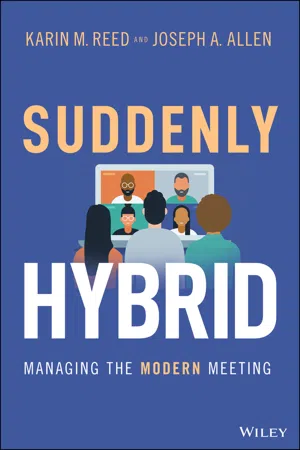
- English
- ePUB (mobile friendly)
- Available on iOS & Android
About this book
Discover the challenges and opportunities of hybrid meetings with this science-based guide from an Emmy-award winning communications expert and renowned organizational psychologist
As remote work becomes less of an unusual exception and more of an everyday necessity, hybrid meetings—meetings in which some attendees are physically present while others are virtually present—are becoming the norm.
In Suddenly Hybrid: Managing the Modern Meeting, Emmy award-winningcommunications expert Karin Reed and veteran industrial and organizational psychologist Dr. Joseph A. Allen deliver a practical and actionable framework for attending, hosting, and managing hybrid meetings. The authors draw from their extensive experience in research and business, as well as firsthand stories and up-to-date studies, to offer a guide that's grounded in science and proven in the real world. You'll learn about:
- Best practices based on research from the height of the pandemic and the unexpected paradigm shifts that resulted
- The challenges and opportunities presented by the trend towards hybrid meetings
- New research insights gathered from those early in the transition to hybrid meetings, as well as those who are well on their way to implementing a complete framework
Perfect for senior business leaders, managers, and even individual contributors, Suddenly Hybrid: Managing the Modern Meeting is required reading for anyone expected to organize, host, or attend virtual or hybrid meetings in their workplace or school.
Frequently asked questions
- Essential is ideal for learners and professionals who enjoy exploring a wide range of subjects. Access the Essential Library with 800,000+ trusted titles and best-sellers across business, personal growth, and the humanities. Includes unlimited reading time and Standard Read Aloud voice.
- Complete: Perfect for advanced learners and researchers needing full, unrestricted access. Unlock 1.4M+ books across hundreds of subjects, including academic and specialized titles. The Complete Plan also includes advanced features like Premium Read Aloud and Research Assistant.
Please note we cannot support devices running on iOS 13 and Android 7 or earlier. Learn more about using the app.
Information
PART ONE
From Suddenly Virtual to Suddenly Hybrid
If you are fully vaccinated, you can resume activities that you did prior to the pandemic. Fully vaccinated people can resume activities without wearing a mask or physically distancing, except where required by federal, state, local, tribal, or territorial laws, rules, and regulations, including local business and workplace guidance. If you haven't been vaccinated yet, find a vaccine. (Centers for Disease Control and Prevention [CDC] 2021)
References
- Buchholz, K. 2021. “65% of remote workers do not want to return to the office – here's why.” World Economic Forum, April 27. Retrieved July 9, 2021 from https://www.weforum.org/agenda/2021/04/survey-65-of-remote-workers-do-not-want-to-return-to-the-office/
- Centers for Disease Control and Prevention (CDC). 2021. “When you've been fully vaccinated: How to protect yourself and others.” Retrieved July 8, 2021 from https://www.cdc.gov/coronavirus/2019-ncov/vaccines/fully-vaccinated.html#vaccinated
- Gaskell, A. 2021. “How productive have remote workers been during COVID?” Forbes, May 31. Retrieved July 8, 2021 from https://www.forbes.com/sites/adigaskell/2021/05/31/how-productive-have-remote-workers-been-during-covid/?sh=2ffa24e9639e
- Montgomery, J. 2021. “New survey: What people really think about hybrid work.” Zoom (blog), April 8. Retrieved from https://blog.zoom.us/new-survey-what-people-really-think-about-hybrid-work/
- Reed, K. M., and J. A. Allen. 2021. Suddenly Virtual: Making Remote Meetings Work. Wiley.
Chapter 1
The Inevitability and Promise of Hybrid Meetings
Table of contents
- Cover
- Table of Contents
- Additional Praise for Suddenly Hybrid
- Title Page
- Copyright
- Dedication
- Preface
- Acknowledgments
- PART ONE: From Suddenly Virtual to Suddenly Hybrid
- PART TWO: Leading a Hybrid Meeting
- PART THREE: Participating with Impact – The Attendee's Turn
- PART FOUR: Power Up – Tools to Bridge the Physical and Virtual Workplaces
- PART FIVE: Setting Expectations
- Conclusion: What to Focus on When the Future Still Seems Blurry
- About the Authors
- About the Website
- Index
- End User License Agreement